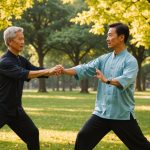As seniors face mobility challenges, maintaining physical fitness can become increasingly difficult. Virtual reality workouts offer an innovative solution, providing engaging and adaptable fitness experiences tailored to individual needs. These immersive sessions not only promote physical activity but can also enhance mental well-being, fostering a sense of community and motivation. Explore how this technology can unlock newfound wellness for seniors, enabling them to overcome obstacles and embrace healthier lifestyles.
Benefits of Virtual Reality Workouts for Seniors
Virtual reality (VR) workouts offer a range of benefits for seniors, enhancing both physical and mental well-being. These immersive experiences can significantly contribute to senior wellness by improving mobility and promoting overall health.
In parallel : Essential Oral Care Tips for Seniors Wearing Dentures: A Comprehensive Guide to Healthy Smiles
Physical Benefits
VR workouts are particularly effective in mobility improvement. They provide a safe and controlled environment where seniors can engage in physical activities that enhance flexibility, strength, and balance. This can lead to reduced risks of falls and injuries, which are common concerns among older adults.
Mental Health Improvements
Beyond physical health, VR workouts can have a positive impact on mental health. Engaging in virtual environments can help alleviate feelings of loneliness and depression. The stimulating nature of these workouts can also improve cognitive functions, offering seniors a fun way to stay mentally active.
Also to read : Unlocking the Power of Aromatherapy: Boosting Well-being for Seniors
Social Engagement Opportunities
VR workouts also open doors for social engagement. Through virtual environments, seniors can connect with others, participate in group activities, and even compete in friendly challenges. This social interaction is crucial for maintaining emotional health and senior wellness, fostering a sense of community and belonging.
In summary, virtual reality workouts offer a comprehensive approach to enhancing the quality of life for seniors, addressing both physical and mental health needs.
Effective Virtual Reality Workouts for Seniors
Virtual reality workouts offer a unique approach to senior fitness, providing a variety of VR workout examples that cater to different needs and preferences.
Popular VR Workout Programs for Seniors
Several senior fitness programs have emerged, offering tailored experiences. Programs like "VR Senior Fitness" and "SilverFit" are designed specifically for older adults, focusing on exercises that enhance strength, balance, and flexibility. These programs often feature scenic environments and engaging activities, making workouts enjoyable and motivating.
Customized Workouts for Mobility Challenges
For seniors facing mobility challenges, tailored exercises in VR can be particularly beneficial. Custom programs can be adjusted to accommodate various physical limitations, ensuring safe participation. By simulating real-world activities, seniors can practice movements that are directly applicable to daily life, aiding in the improvement of functional mobility.
Case Studies of Successful VR Implementation
Numerous case studies highlight the success of VR in senior wellness. For instance, a study involving a group of seniors using VR for exercise reported improved balance and reduced fall risk. Participants also noted increased motivation and enjoyment compared to traditional exercise methods, showcasing the potential of VR to transform senior fitness.
Accessibility Features of Virtual Reality for Seniors
Virtual reality (VR) is becoming increasingly accessible to seniors, thanks to advancements in VR accessibility and senior-friendly technology. These developments ensure that older adults can benefit from immersive experiences without unnecessary complexity.
Devices Designed for Ease of Use
VR devices are now crafted with inclusive design in mind, focusing on simplicity and usability. Headsets are lightweight and adjustable, accommodating different head sizes and ensuring comfort during use. This thoughtful design makes it easier for seniors to engage with VR technology.
User-Friendly Interfaces and Controls
The interfaces and controls of VR systems have been simplified to enhance VR accessibility. Large, clear icons and intuitive navigation reduce the learning curve, allowing seniors to operate these devices with confidence. Voice-activated commands further streamline the user experience, offering an alternative to traditional controls.
Adaptations for Varying Levels of Mobility
Recognising the diverse mobility levels among seniors, VR developers have incorporated features that cater to these needs. Seated experiences and adjustable settings ensure that seniors with limited mobility can still participate fully. These adaptations highlight the commitment to inclusive design, enabling all seniors to enjoy the benefits of virtual reality.
Expert Insights on VR Technology and Senior Health
Incorporating expert opinions from geriatric specialists and VR developers provides a comprehensive view of how virtual reality is reshaping senior health. Interviews with health professionals reveal that VR technology is increasingly being recognized for its potential to enhance senior wellness. Geriatric specialists emphasize the importance of VR in promoting physical activity and mental engagement, highlighting its role in reducing fall risks and improving cognitive functions.
Research findings support these insights, demonstrating positive outcomes in senior health when VR is integrated into wellness routines. Studies indicate that seniors engaging with VR experience improved balance, increased motivation, and enhanced mood. These benefits are attributed to the immersive and interactive nature of VR, which encourages active participation and social interaction.
Looking ahead, experts predict that VR technology will continue to evolve, offering even more tailored solutions for seniors. Future developments may include more personalized programs and advanced accessibility features, ensuring that all seniors can benefit from this innovative technology. As VR technology insights continue to emerge, health professionals remain optimistic about its potential to transform senior health care, paving the way for a more engaged and healthier aging population.
Challenges Seniors Face with Virtual Reality
Navigating VR challenges can be daunting for seniors, as they often encounter significant technology hurdles. One common issue is the complexity of setting up VR devices. Seniors may struggle with connecting headsets to computers or updating software. To mitigate these technical difficulties, manufacturers are increasingly offering step-by-step guides and customer support.
Senior barriers to VR also include fear or apprehension towards new technologies. Many older adults may feel overwhelmed by the rapid pace of technological change, leading to reluctance in trying VR. Encouraging participation through introductory sessions and peer support can help ease these concerns, fostering a more welcoming environment.
Physical limitations further complicate VR usage for seniors. For instance, prolonged use of VR headsets can cause discomfort or dizziness, particularly for those with mobility issues. To address these challenges, developers are creating shorter, seated experiences that minimize strain. Additionally, adjustable settings allow users to tailor the experience to their comfort level, reducing the risk of adverse effects.
By understanding and addressing these VR challenges, the technology becomes more accessible, allowing seniors to enjoy the numerous benefits VR offers.
Recommendations for Suitable VR Programs and Devices
Selecting the right virtual reality setup can significantly enhance the experience for seniors. Understanding the recommended VR programs and identifying the best devices for seniors are crucial steps in this process.
Top VR Devices for Seniors
When considering the best devices for seniors, factors such as ease of use and comfort are paramount. Devices like the Oculus Quest 2 and HTC Vive Focus 3 are highly recommended due to their user-friendly interfaces and lightweight designs. These headsets are praised for their inclusive design, making them accessible for seniors with varying levels of tech-savvy.
Best Practices for Safe VR Usage
Ensuring safety in VR usage involves adhering to several best practices. Seniors should start with shorter sessions to avoid discomfort. It's important to have a clear, obstacle-free space to prevent accidents. Adjusting settings to suit individual comfort levels can also enhance the experience, reducing the risk of dizziness or strain.
User Reviews and Testimonials
User reviews consistently highlight the positive impact of VR on senior wellness. Many seniors report increased motivation and enjoyment in their fitness routines. Testimonials often mention how VR has improved their social engagement and cognitive functions, underscoring the transformative potential of this technology.
Future of Virtual Reality in Senior Fitness
The future of VR in senior fitness is promising, driven by technological advancements and evolving trends in senior wellness. As VR technology continues to develop, we can expect more sophisticated and accessible solutions tailored to older adults.
Emerging Technologies in VR
Emerging technologies in VR are set to revolutionise senior fitness. Innovations such as haptic feedback and enhanced motion tracking will create more immersive and engaging experiences. These advancements will enable seniors to participate in a wider range of activities, from gentle exercises to more dynamic workouts, promoting overall health and well-being.
Potential Growth of VR Fitness Programs for Seniors
The potential growth of VR fitness programs for seniors is significant. As awareness of the benefits of VR increases, more programs are likely to emerge, offering diverse and customised options. These programs will cater to various fitness levels and interests, ensuring that seniors can find suitable activities that motivate and inspire them.
Predictions for the Impact of VR on Senior Wellness
In the coming years, the impact of VR on senior wellness is expected to be transformative. Predictions suggest that VR will become a mainstream tool in senior fitness, enhancing both physical and mental health. This integration will lead to improved quality of life, greater independence, and a more engaged aging population.











